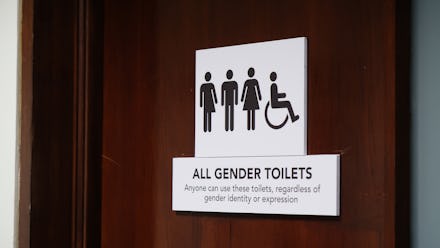All-gender access and floor-to-ceiling walls: The world’s most inclusive bathroom is here

On Sunday, the New York Times reported the Trump administration’s plans to redefine the legal term “gender” as “a biological, immutable condition determined by genitalia at birth” — effectively compromising the rights of transgender and intersex individuals everywhere.
Narrowly limiting the criteria that defines gender would reverse the Obama administration’s previous interpretation of discrimination on the basis of “sex,” which also included “gender identity.” This guidance formerly allowed transgender students the right to use bathrooms consistent with their gender identity. (In February 2017, the Trump administration also rescinded these bathroom protections for transgender people.)
In response to the ongoing news, one project is being recognized for tackling restrictive sex-segregated bathrooms, which force many trans and gender non-conforming people to choose a restroom they don’t identify with. Stalled, a project created in 2015, is collaborating with Gallaudet University in Washington to renovate and create, perhaps, the most inclusive bathroom and changing area in the world. These rooms will incorporate a number of accessible design elements for everyone, including those with disabilities and people with caregivers.
According to Susan Stryker, a co-founder of Stalled, the restroom will be an all-gender bathroom, meaning mixed-use among everyone, allowing more comfortable access for those who can’t safely access existing “male” and “female” labelled restrooms, she said over the phone. Design elements of this restroom include fully enclosed toilets with floor-to-ceiling walls instead of stalls that compromise privacy, and communal areas for washing and grooming.
Stryker said it’s important that privacy is provided for transgender people within enclosed toilets, but not used to alienate those who don’t conform to the gender binary. Removing many of the walls in communal spaces increases spatial awareness and helps reduce the threat of violence against transgender people, she said.
In addition, the restroom will feature other inclusive elements like ambulatory-accessible stalls for people who use canes or walkers, caregiver rooms with sinks and changing tables, sufficient space for wheelchair users and a lounge as a congregational “animated social space.”
The two changing areas, on a lower level of the Gallaudet University facility, will similarly be wheelchair-accessible, as well as contain a seated bench and a fold-down space for Muslims practicing ablution, a cleansing ritual before prayer. Outside the changing areas, a large vestibule entrance area is planned with storage lockers and a rest area, welcoming visitors into the building.
“It became more and more clear to us [that] there are many kinds of lives and bodies that aren’t well served by the ‘built’ environment. And the public toilet is one of the most highly regulated, coercive environments, literally built around a binary that doesn’t fit around a lot of peoples’ lives.”
Stalled first began as an ongoing research project on the accessibility of public restrooms for transgender people. But after recent events which voted away the rights of transgender individuals’ to restrooms in accordance with their gender identity in Houston and Charlotte, North Carolina, the attention to inclusive restrooms necessitated action, according to Stryker.
“It became more and more clear to us [that] there are many kinds of lives and bodies that aren’t well served by the ‘built’ environment,” she said. “And the public toilet is one of the most highly regulated, coercive environments, literally built around a binary that doesn’t fit around a lot of peoples’ lives.”
Beyond design, another effort by Stalled includes creating a best practices guide to the existing International Plumbing Code, legislation that sets minimum regulations for plumbing in the U.S. Making language clearer and less redundant could make the hurdles associated with constructing inclusive restrooms easier, she said.
Stryker added that for those considering more inclusive public restrooms, existing bathrooms can easily be retrofitted to incorporate these design elements without necessarily posing extreme cost issues or requiring extra space.
On Tuesday, the American Institute of Architects, a group that recognizes the use of progressive practices among architects, gave Stalled an Innovation Award for its design practices. The recent recognition and attention have spurred Stalled’s organizers to create a design firm, in the hopes of consulting with businesses in creating more inclusive spaces everywhere, Stryker said.
“We hope to implement some of these practices in other kinds of spaces that can be similarly designed, not just toilets, but any other building type: public thoroughfares, museums, prisons, detention facilities, universities,” Stryker said. “What are the unnamed assumptions built into them that limit access for different kinds of peoples and [how can we] work to redesign those spaces to make them accessible — instead of excluding?”